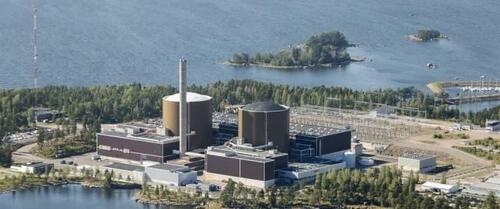
Nuclear Making A Comeback In US, Europe
Authored by Andrew Topf via OilPrice.com,
-
A resurgence in nuclear energy is now underway, fueled by rising energy security concerns, climate goals, and soaring uranium prices.
-
The U.S. and parts of Europe are embracing a nuclear revival, with President Trump targeting a quadrupling of U.S. nuclear capacity by 2050.
-
European nations such as Denmark, Spain, and Germany are signaling renewed openness to advanced reactor technologies.
The Fukushima disaster soured the world on nuclear energy and the uranium industry after tsunami waves inundated Japan’s Fukushima Daiichi nuclear power complex on March 11, 2011.

The tsunami, triggered by a major offshore earthquake, disabled the plant’s cooling systems, causing three reactors to overheat and partially melt down, with subsequent releases of radioactive materials into the air and ocean.
As the world watched in horror, public and government confidence in nuclear power plummeted, leading some countries to phase out or halt nuclear power development plans.
Germany, Belgium and Italy decided to phase out nuclear power or halt planned expansions, while Spain and Switzerland elected not to build new plants.
The accident led to stricter safety requirements and more thorough assessments of existing nuclear plants.
In Japan, nuclear power’s contribution to electricity generation dropped dramatically, with coal-fired plants filling the gap.
The accident spurred increased focus on alternative energy sources like gas, coal, and renewables, as well as a push for new reactor designs with improved safety features.
The event also took its toll on the uranium market and companies that explore for and mine the nuclear fuel. Post-Fukushima, the slump in demand cratered uranium prices, with the market bottoming out near $30 a pound in mid-2014.
Fast-forward to 2022, and the story changes. Spurred by renewed demand for nuclear energy and a leap in yellowcake prices following Russia’s invasion of Ukraine, uranium miners began reviving mothballed uranium projects.
Uranium hit a 10-year high of $105.49/lb on Jan. 29, 2024, and closed out last year with a spot price of $72.63 and a long-term price of $80.50, according to Canadian uranium miner Cameco.
Uranium futures rose to $72 per pound in late May, the highest in nearly three months, and extending the rebound from 18-month lows in March as the possibility of political support for the nuclear sector outweighed the view of ample supply, said Trading Economics.
Despite skepticism from some quarters on the safety of nuclear, there are just as many who believe it is a relatively benign form of baseload power that is necessary for the transition from fossil fuels to renewables. Nuclear, the argument goes, is emissions-free but does not suffer the intermittency problem of wind and solar.
One of the more recent cheerleaders of nuclear is Donald Trump.
Last Friday the US president signed executive orders pledging to expand American nuclear energy capacity from approximately 100 gigawatts in 2024 to 400 GW by 2050.
„Swift and decisive action is required to jumpstart America’s nuclear energy industrial base and ensure our national and economic security by increasing fuel availability and production, securing civil nuclear supply chains, improving the efficiency with which advanced nuclear reactors are licensed, and preparing our workforce to establish America’s energy dominance and accelerate our path towards a more secure and independent energy future,” World Nuclear News quoted from the executive order ‘Reinvigorating the Nuclear Industrial Base’.
A Fox News article posted on the White House website states:
Through a series of executive orders signed this week, President Trump is taking action to usher in an American nuclear renaissance. For the first time in many years, America has a path forward for quickly and safely testing advanced nuclear reactor designs, constructing new nuclear reactors at scale, and building a strong domestic nuclear industrial base…
This week’s executive actions will help us reach that goal in four ways.
First, we are going to fully leverage our DOE national laboratories to increase the speed with which we test new nuclear reactor designs. There is a big difference between a paper reactor and a practical reactor. The only way to bridge that gap—understanding the challenges that must be surmounted to bring reactors to the market, and building public trust in their deployment—is to test and evaluate demonstration reactors.
Second, for our national and economic security, we are going to leverage the Departments of Defense and Energy to build nuclear reactors on federally owned land. This will support critical national security needs which require reliable, high-density power sources that are invulnerable to external threats or grid failures.
Third, to lower regulatory burdens and shorten licensing timelines, we are asking the NRC to undergo broad cultural change and regulatory reform, requiring a decision on a reactor license to be issued within 18 months. This will reduce regulatory uncertainty while maintaining nuclear safety. We will also reconsider the use of radiation limits that are not science based, impossible to achieve, and do not increase the safety of the American people.
There are currently 54 nuclear power plants operating in the United States, with 28 states having at least one reactor. According to the Energy Information Agency (EIA), Unit 3 at the Alvin W. Vogtle Electric Generating Plant in Georgia entered serviced on July 31, 2023 as part of a two-unit expansion project. It has 1,117 megawatts (MW) of net summer electricity generation capacity.
Unit 4, a Westinghouse AP1000 pressurized light water reactor, began commercial operations in April 2024. It is now the largest nuclear power plant in the United States, with four reactors and a total of 4,536 MW net summer electricity generation capacity.
Meanwhile, in Europe, the birthplace of the anti-nuclear movement, there has also been a rethink of nuclear power as countries pursue more energy independence.
As CNBC reports, In just the last few weeks, Denmark announced plans to reconsider a 40-year ban on nuclear power as part of a major policy shift, Spain reportedly signaled an openness to review a shutdown of its nuclear plants and Germany dropped its long-held opposition to atomic power.
Denmark banned the use of atomic energy in 1985. It is important to point out that the Danish government is not considering a return to traditional nuclear power plants. Rather, The renewables-heavy Scandinavian country said in mid-May that it plans to analyze the potential benefits and risks of new advanced nuclear technologies, such as small modular reactors, to complement solar and wind technologies.
Spain’s Environmental Transition Minister said in late April that, while the government is proceeding with plans to retire nuclear reactors over the next decade, extensions beyond 2035 could not be ruled out.
The statement by Minister Sara Aagesen followed a catastrophic power outage affecting much of Spain, Portugal and southern France.
Germany, which closed the last of its three remaining nuclear plants in 2023, recently dropped its objection to French efforts to ensure that nuclear power is treated on a par with renewables in EU legislation, the Financial Times reported on May 19, citing French and German officials.
Tyler Durden
Fri, 05/30/2025 – 05:00











![Kolejny wypadek w pobliżu Castoramy w Toruniu [ZDJĘCIA]](https://tylkotorun.pl/wp-content/uploads/2025/05/1212.jpg)


![Handlował podrabianą odzieżą. W mieszkaniu miał prawie 200 sztuk [ZDJĘCIA]](https://radio.lublin.pl/wp-content/uploads/2025/05/350-267488-2025-05-31-175537.jpg?size=md)



